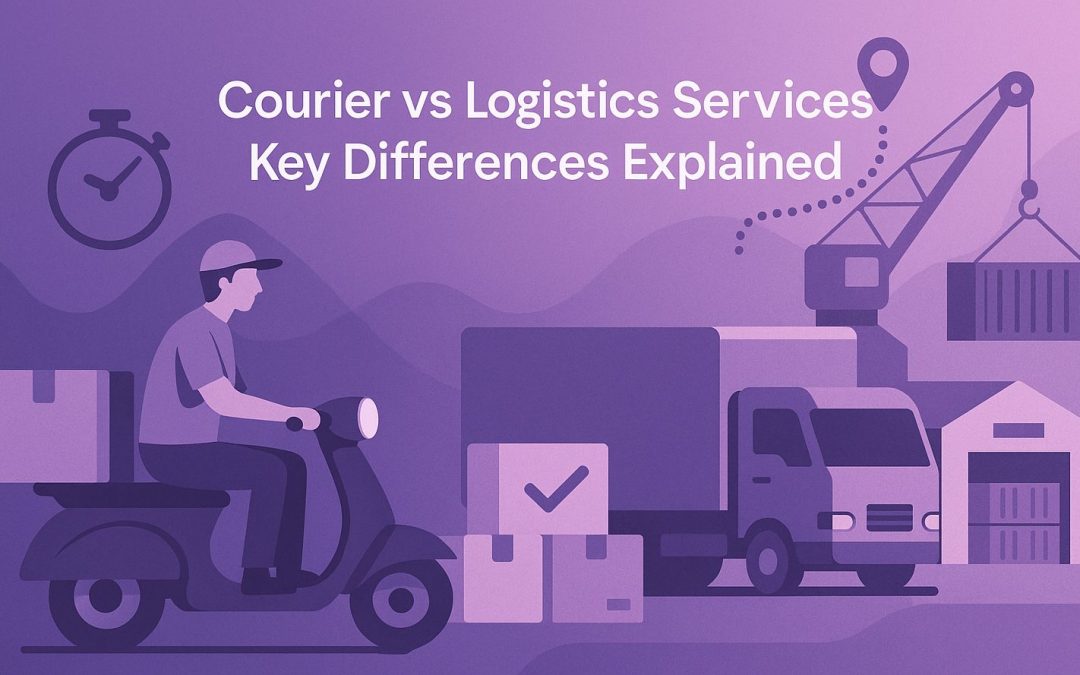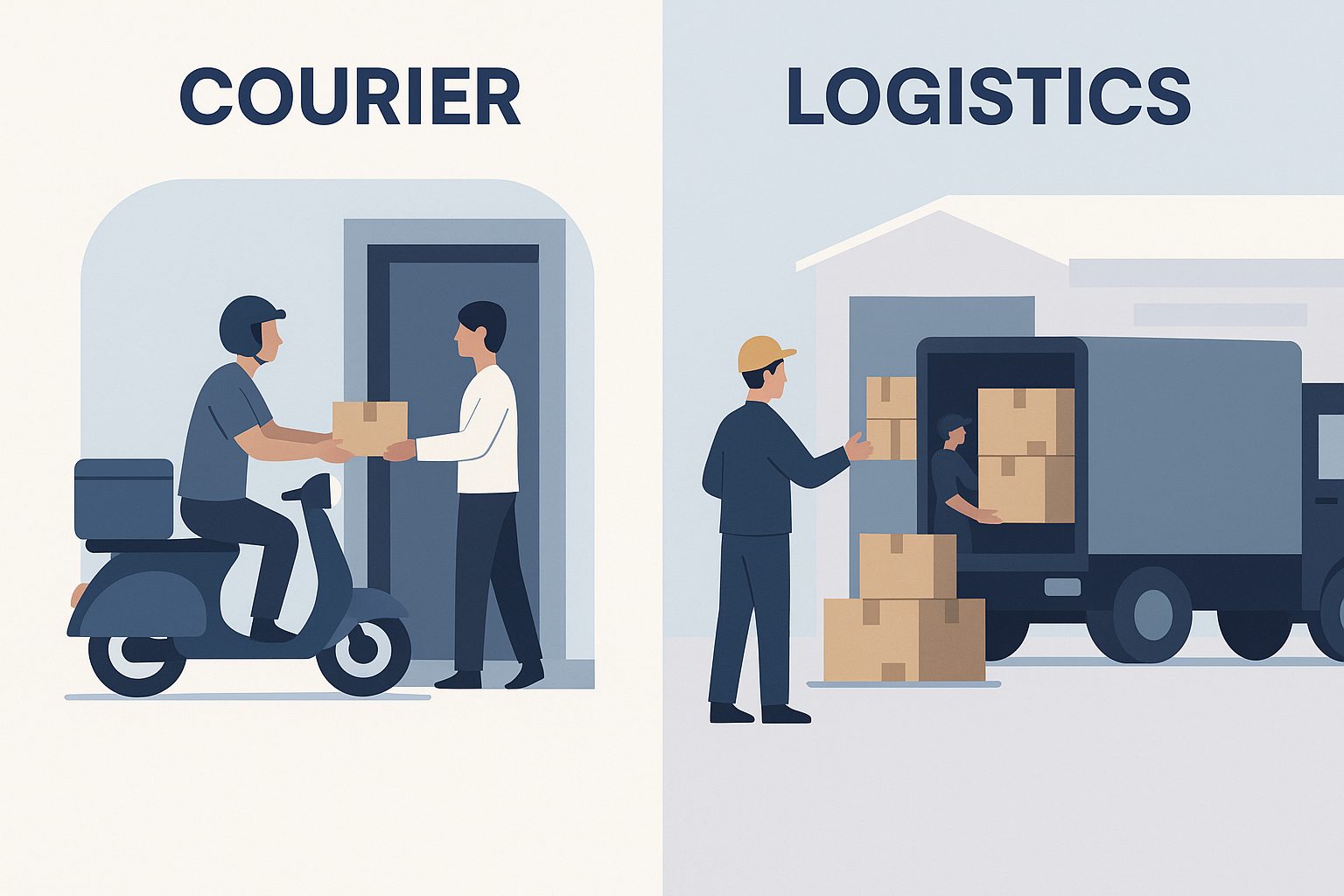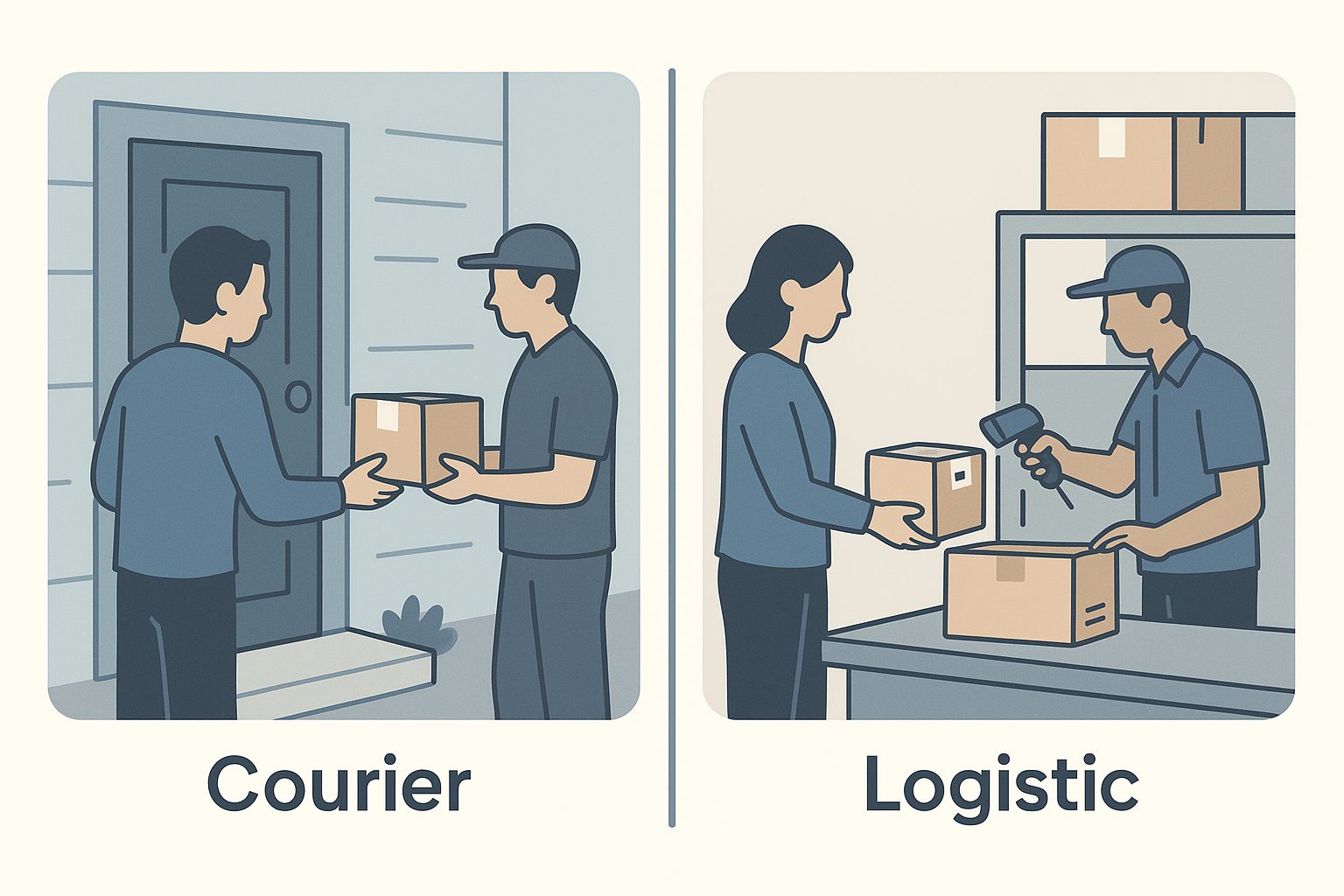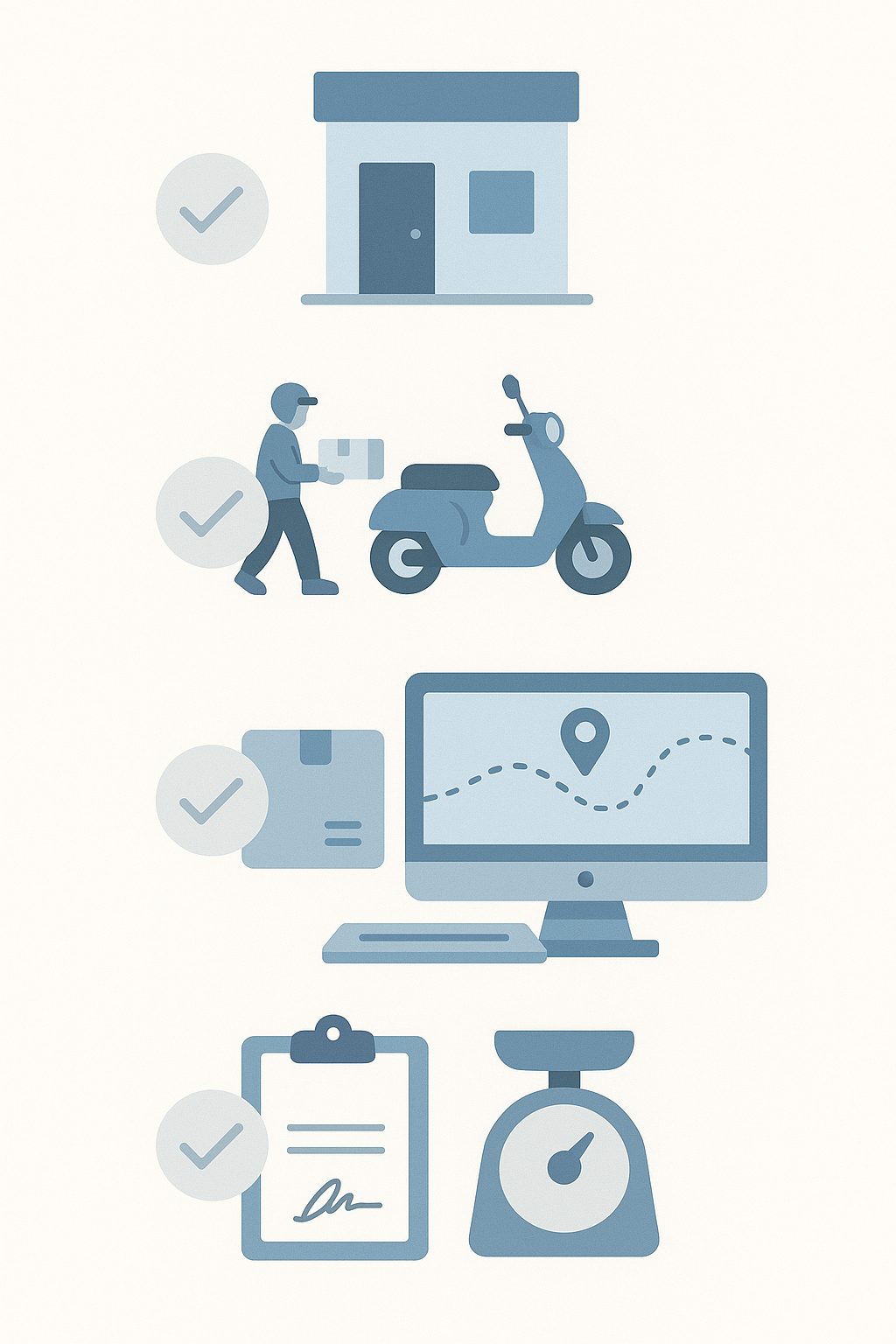Table of Contents
In India’s fast-growing trade and commerce landscape, the terms courier and logistics show up everywhere — from doorstep deliveries to warehouse operations. And while they’re both tied to the movement of goods, they serve very different purposes.
Courier services are best known for speed and simplicity. You need to send a document across town? Or ship a small parcel to another city by morning? A courier service gets it there — quickly and directly.
Logistics, on the other hand, covers the entire supply chain journey. It’s not just about delivering a package — it’s about managing where goods are stored, how they move across distances, and how they’re handled at each step.
Still, many businesses don’t always know when to use which. This guide breaks down the differences between courier and logistics services — so you can make better, more cost-effective choices for your shipments.
Meaning of Courier Service
Courier services are built for speed. Whether it’s a business sending out invoices or a student dispatching documents to a university, couriers are the go-to for small, time-sensitive deliveries. They’re fast, simple, and usually come with door-to-door service.
Most people use courier services when the parcel is light — maybe a few documents, a small gift, or an online order. These aren’t bulk goods or freight shipments. We’re talking about items that can be picked up and delivered quickly, often within the same day or the next.
In India, courier services operate in every major city and even in smaller towns. Some companies focus on metro-to-metro delivery, while others cover remote pin codes. Many also offer real-time tracking, SMS alerts, and proof of delivery — features that have now become the norm.
It’s worth noting that courier charges are often higher when compared to postal or standard freight services, especially for urgent or international deliveries. But what you’re paying for is convenience, speed, and minimal handling.
Some of the well-known courier companies in India include:
- Blue Dart
- DTDC
- India Post (Speed Post)
- First Flight Couriers
- The Professional Couriers
Each one has its strengths. Some are better for local deliveries, others specialise in international routes or express options.
Meaning of Logistics Service
Logistics isn’t just about moving stuff from one place to another — it’s about making sure the entire process runs smoothly, from the first step to the last. When a company needs to store goods, pick the right items, pack them, load them onto the right vehicle, and get them delivered — that’s logistics.
It covers more than transport. It includes warehousing, inventory checks, packaging, route planning, and sometimes even returns. If there’s a system behind how goods get from the factory to the store shelf, that’s logistics in action.
Most logistics companies handle heavy and large shipments — not single parcels or small envelopes. They deal with cartons, crates, truckloads. And they work with clients who move goods in bulk — manufacturers, distributors, eCommerce sellers, exporters. It’s less about speed and more about managing scale without mistakes.
Depending on the location and size of the shipment, they might use trucks, rail, air freight, or shipping containers. Logistics is also where things like first-mile and last-mile delivery come in — getting items from a factory to a warehouse, and from a warehouse to a retail outlet or customer doorstep.
In India, these are some of the major logistics players:
- GATI
- Delhivery
- Allcargo
- VRL Logistics
- Ekart
- FedEx (for bulk logistics)
- DTDC (logistics arm)
Each of these works at different levels — some focus on regional shipping, some on national freight, and others on global supply chains.
Courier vs Logistics: How They Actually Differ
Courier and logistics both deal with moving goods — but they don’t do the same kind of work.
Couriers are built for speed. They handle small parcels, usually with direct delivery. Logistics deals with volume. It handles goods in bulk, across different legs of the supply chain. Most businesses use both at different stages — but knowing which one to use (and when) makes a difference in cost, time, and control.
Comparison Table: Courier vs Logistics
| Factor | Courier Service | Logistics Service |
| Purpose | Deliver small parcels quickly | Manage bulk movement of goods from source to destination |
| Package Type | Documents, small boxes | Cartons, pallets, large shipments |
| Users | Individuals, small offices, local shops | Manufacturers, warehouses, online sellers |
| Delivery Speed | Fast — same-day or next-day options | Depends on route, load size, and transport method |
| Transport Mode | Mostly bikes, vans, and air | Trucks, rail, sea, and sometimes air |
| Returns Handling | Only if delivery fails | Often includes reverse logistics (returns, replacements) |
| Tracking Detail | Basic updates (out for delivery, delivered) | Multi-point tracking (warehouse, dispatch, delivery) |
| Cost | Higher for single shipments or per-kilo rates | Lower per unit when sending in bulk |
| Extra Services | Limited (maybe packaging, COD) | Full-stack (storage, sorting, packing, scheduling) |
In Simple Terms,
If you’re sending a couple of envelopes or small packages across town, courier is the way to go.
If you’re shipping 200 boxes to five cities over the next week — that’s logistics. Courier won’t cut it.
Courier is fast but narrow. Logistics is slower, but handles more moving parts.
Both have their place. But they’re not built for the same job.
What’s Right for Your Business?
There’s no one-size-fits-all answer here. The right choice depends on what you’re shipping, how often you ship, and how far it needs to go.
If you’re running a shop that sends out small parcels — maybe 2–3 deliveries a day, mostly within the city — a courier service makes more sense. It’s fast, doesn’t need much coordination, and the pricing is predictable.
But if you’re a business that moves stock between warehouses, supplies products to retailers, or ships large orders across states — then you’re dealing with logistics. You need a service that can handle scale, storage, and route planning. Courier won’t be able to manage that without costs ballooning.
A Quick Way to Decide
Ask yourself:
- Are you shipping small or large quantities?
- Is speed more important, or cost and control?
- Do you need tracking and delivery, or full supply chain handling?
- Are you sending one item at a time, or moving bulk shipments regularly?
- What about returns? Do you need reverse pickups or restocking support?
In Plain Speak
- Use courier when you need something picked up and dropped fast.
- Use logistics when you’re managing movement of goods at scale.
Sometimes, you’ll need both — and that’s fine. Lots of businesses use couriers for urgent dispatches and logistics for regular stock movement.
Tracking Isn’t the Same
Both courier and logistics companies offer tracking. But how much they tell you — and how accurate it is — varies a lot.
With couriers, the updates are basic. You’ll get a handful of status messages:
“Picked up,” “Out for delivery,” “Delivered.”
Sometimes there’s a delay message. Not much else.
It works fine if you’re sending a document or a small box. But if you’re managing a large shipment or multiple deliveries at once, this won’t be enough.
Logistics tracking is more detailed. You’ll often get updates like:
Goods received at warehouse → Loaded → In transit → Arrived at Hub → Assigned for delivery → Delivered
Some even show stop locations, driver details, delays, and route status. It’s built for scale.
| Feature | Courier Tracking | Logistics Tracking |
| Update Frequency | Low – only key stages | High – covers multiple points in the delivery cycle |
| Typical Messages | Picked up, Out for delivery, Delivered | Hub scanned, Vehicle loaded, In transit, Delivered |
| Level of Detail | Basic | Detailed, sometimes with timestamps and route info |
| Real-time Accuracy | Depends on the vendor | More consistent, especially for long-haul shipments |
| Tech Involvement | Standard apps or SMS updates | Often uses integrated logistics platforms |
| Use Case Fit | Good for individual parcels | Needed for bulk orders and high-value consignments |
In short:
Courier tracking tells you where the package is.
Logistics tracking tells you where it’s been, what’s happening now, and what’s next.
If you’re managing one order, courier tracking does the job.
If you’re managing five shipments across three states, you’ll want the kind of updates only logistics companies can give.
Returns: How Couriers and Logistics Handle Them
Couriers don’t really do returns. Not in the proper sense.
If the person at the other end doesn’t pick up the parcel — wrong address, unavailable, or just refused — the courier brings it back. That’s it. The package comes back because the delivery didn’t go through. It’s not a return service. It’s a failed drop.
Logistics is different. Returns are built in. In industries like eCommerce, returns are routine. Customers send things back, ask for exchanges, request pickups. A logistics company handles all of that — from picking up the returned item, scanning it in, bringing it back to the warehouse, sometimes even repacking and reshipping.
This is called reverse logistics. It’s not a fancy add-on. It’s a basic requirement if you’re moving products at scale.
Courier services aren’t set up for this. Logistics providers are.
Quick Comparison
| Returns Feature | Courier | Logistics |
| Customer return pickup | Not offered | Yes, can be scheduled |
| Failed delivery | Package returned to sender | Same, but logged and tracked |
| Exchanges/replacements | Not handled | Can be managed |
| Tracking for returns | Rare or limited | Often detailed |
| Built for scale returns? | No | Yes |
If your customers ever send things back, you need logistics — not a courier with a return sticker.
Cost and Pricing
Here’s the short version:
Courier is cheaper for one box. Logistics is cheaper when you’re shipping ten.
Couriers charge based on parcel size, weight, and urgency. Want it there tomorrow? You’ll pay more. It’s great for light stuff — documents, small boxes. But send five parcels, and you’ll notice the bill stacks up fast.
Logistics works differently. You pay based on space — part-load, full-load, weight slabs. The more you send, the better it works out per kilo. It’s not built for one-off deliveries. But for regular shipments or bulk movement, it saves money over time.
Couriers are like booking a cab.
Logistics is like hiring a truck. If the truck’s half-full, it’s still yours.
Cost Comparison Example
| Shipment | Courier (₹) | Logistics (₹) |
| One 5 kg parcel, local | ~150–250 | Not applicable |
| Two 15 kg parcels, intercity | ~800–1,000 | ~500–700 (LTL) |
| 200 kg of stock, warehouse move | Very expensive | ~₹3,000–₹4,000 |
| Monthly bulk shipments (1 ton) | Not viable | Best pricing |
Note: Prices vary by location, provider, and urgency. These are ballpark.
What to Remember
- Courier costs spike if you’re shipping multiple small boxes.
- Logistics costs drop as your shipment size grows.
- Urgency always adds to the cost — for both.
If you’re sending once in a while, courier works.
If you’re running regular stock movement — logistics will save you money.
What to Expect if You Open a Courier or Logistics Franchise
Franchises are how most courier and logistics companies grow. They don’t open offices everywhere — they give local partners the rights to run things in certain areas.
If you’re thinking of applying for one, here’s what it really involves.
What You’ll Need to Do
First, choose who you want to work with. DTDC, Delhivery, GATI, Blue Dart — most big players offer franchise models. Each one runs things a bit differently.
Start by asking questions. How big is the service area? Do they want you to cover one pin code or twenty? What kind of space do they need for pickups and deliveries? Will they provide software and training? Do you need to arrange your own delivery staff?
Costs vary a lot. Some ask for deposits, others for basic infrastructure. You’ll need a small office or counter, maybe a weighing scale, computer, internet, and staff. Most expect you to hit a monthly shipment target. If you fall short, you may lose your franchise.
Once they approve you, you’ll get access to their system. From there, you start operations — taking in packages, arranging deliveries, and managing day-to-day issues.
It’s not glamorous. It’s local logistics work. You’ll deal with delays, complaints, tracking issues, and staff problems. Some days will go smoothly. Others won’t.
Rough Cost Ranges (Realistic)
| Company | Franchise Type | Setup Cost Range |
| DTDC | Local courier counter | ₹75,000–₹2 lakh |
| Blue Dart | Hub or sub-regional ops | ₹2.5–₹5 lakh |
| Delhivery | Pickup/delivery point | ₹60,000–₹1.5 lakh |
| GATI | Transport & cargo partner | ₹1–₹2 lakh |
| The Professional Couriers | Counter franchise | ₹50,000–₹1 lakh |
Note: These are ballpark. Always ask the company for updated, official numbers.
Should You Do It?
Only if you’re prepared to run it full-time. This isn’t passive income. You’ll be managing deliveries, tracking delays, answering calls, dealing with staff, handling cash on delivery, and more.
If you have space in a good location and you know your area well, it can work.
If you’re expecting easy money or light work — don’t bother.
Conclusion
Courier and logistics services aren’t better or worse than each other. They’re built for different jobs.
If you’re sending a few small parcels a week, go with a courier. It’s fast, simple, and gets the job done.
If you’re moving bulk stock, coordinating deliveries, or handling returns — you’ll need logistics. Couriers aren’t made for that kind of work.
Some businesses use both. A courier for small urgent stuff. Logistics for everything else. That’s normal.
The important thing is knowing what you need. If you pick the wrong option, you’ll either spend too much — or end up with delays and problems down the line.
Make the choice based on the size of your shipments, how often you send them, and how much control you need.
No overthinking. Just use what works for your business.
Need reliable logistics solutions for your business?
Tata nexarc helps businesses streamline their supply chain with trusted transporters, competitive pricing, and real-time tracking—ensuring timely and cost-effective delivery across India.
FAQs
What is last-mile delivery and why does it matter?
Can logistics companies offer same-day delivery like couriers?
How do third-party logistics (3PL) providers work?
Are couriers or logistics companies better for international shipping?
Is GST applicable on courier and logistics services?
What are typical SLAs for courier vs logistics providers?
Can a business switch between courier and logistics providers easily?
What role does packaging play in courier vs logistics shipping?
Do courier companies offer warehousing services?
Rarely. Most couriers focus on pickup and drop. Warehousing is typically a logistics service.
What are the environmental impacts of courier vs logistics services?
Sohini is a seasoned content writer with 12 years’ experience in developing marketing and business content across multiple formats. At Tata nexarc, she leverages her skills in crafting curated content on the Indian MSME sector, steel procurement, and logistics. In her personal time, she enjoys reading fiction and being up-to-date on trends in digital marketing and the Indian business ecosystem.









